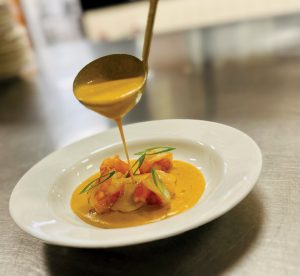 By Paul Suplee,
By Paul Suplee,
MBA, CEC, PC-3
Man, I am on a serious soup kick lately, proof positive that I am getting old.
I never was a “soup guy” until a few years ago, but what can I say about soup that hasn’t already been said?
It’s delicious? Most of the time, it’s hot? Unless the cook really screws the pooch, it’s flavorful?
I don’t know, I just like soup, especially in the wintertime. I guess as we age our blood thins a little and we’re always mimicking Eddie Murphy’s grandmother in asking for another blanket for our knees.
Oh, to be young again, knowing what I know now.
The skill of a good cook can be summed up in their soup-making capabilities.
One of the great uses of a soup is the use of leftovers and scraps, be it at home or in a restaurant.
The utilization of every ounce possible is key in preserving our precious, yet seemingly limited, funds. And this is the true mark of a good cook and chef.
The beauty of bisque is two-fold.
The primary lust factor of this mighty soup is its richness. It is unctuous, creamy and satiating, almost making a complete meal in and of itself.
The secondary attraction for this soup is the flavor.
Traditionally (as I did in this recipe) the shells of the crustacean, whether it be shrimp or lobster, are included in the finished product.
They are pulverized and pureed in the blender or food mill. The concoction is then strained through a sieve and any larger chunks will be removed.
However, the tiny and imperceptible bits of shell in the finished product act as a shrimp base of sorts, their flavor only adding to the finished product.
I was sharing this with my students last night, and at first, they were disgusted.
Then, I shared my story of Infantry School at Camp LeJeune, North Carolina in 1988.
Located in the Carolinas, I was ecstatic at the choice of food in the chow hall; steamed shrimp, rabbit, frog legs and other country-folk vittles were readily at hand, and I loved it.
What I noticed, though, was that all of the Carolina boys never peeled their steamed shrimp. They simply ate them, shell and all.
I still peeled mine, but I remember sitting there and thinking about making bisques at Johnson & Wales the year prior, using the shells to enhance and fortify the flavor of the bisque.
And then I shared another story about where crab base comes from.
One student audibly groaned and said “Chef, please don’t ruin it for me.”
Well, Student, it is my job to ruin things for you in the name of education, so away we go.
Apparently, and I did not know this until I watch an episode of “Dirty Jobs” with Mike Rowe, once the crabs are picked, the shells and remains of said crabs plus the seasonings in which they are cooked are run through a pulverizing machine.
This homogenizes them into a well-seasoned base that is then sold to distributors for their self-labeled crab base. And now you know as well. You are more than welcome.
Either way, a good soup is a good soup.
Enjoy this while the weather is still chilly and practice it until it is second nature. Soon, you won’t even need a recipe.
Shrimp Bisque
makes about 1 gallon
2# Shrimp, shell on
2 qt. Chicken stock (optional: If you want only seafood, use 1 gallon seafood stock)
Butter as needed
2 qt. Shrimp or seafood stock
1/2 ea. White onion, roughly chopped
1 piece celery, roughly chopped
1 med. Carrot, peeled and chopped
1 leek, washed and roughly chopped
2 Tbsp. Garlic cloves, smashed
1/4 tsp. Cayenne pepper
1/4 c. Dry sherry
1/4 c. Brandy
6 Tbsp. Tomato paste
12 oz. Blonde roux
2 c. Heavy cream
Salt & Pepper to taste
- Peel the shrimp, placing the shells in the stock and simmering for 30 minutes.
- In a large pan, heat the butter and get a decent sauté on the onions, celery, leeks, carrot and garlic.
- Add cayenne and deglaze the pan carefully with brandy and sherry.
- When you have extracted as much shrimp essence as possible (and honestly this isn’t all that critical and you will see why in a moment), add this to the vegetables.
- Add the tomato paste and pull off the stove for now.
- Place contents in batches in a good blender (Vitamix is my go-to) and blend ever so carefully until smooth.
- Once it is pureed, run it through a sieve or fine food mill to remove any little bits that may not have gotten pulverized.
- Return this to the stovetop and bring to a simmer. Whisk in the roux and allow it to heat up so that the thickening properties can do their magic.
- Add cream, continuing to simmer. This will allow it to reduce ever so slightly, fortifying the flavors that you have combined in your cauldron.
- Season to taste and keep warm.
- For garnish, cook the peeled shrimp using a seasoning of your choice. I stay away from Seafood Seasoning as that tends to overpower this already rich and succulent bisque, but you do whatever makes your heart happy. Top the bisque with cooked shrimp and greens of your choosing and enjoy this mid-winter liquid gold.
— Paul Suplee is the owner of
boxcar40, boxcar on main,
boxcar crafted events and
sportfish catering.
www.boxcarrestaurants.com
